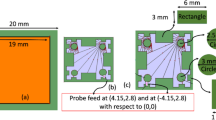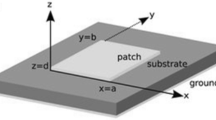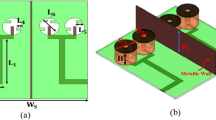Abstract
Over the years, increasing demand of microstrip patch antennas have made them desirable prospects for applications in the wireless communications field. The rise in popularity is attributed to their miniature sizes, thereby proving effectiveness in the fabrication process. Despite all these features, major drawback of these structures is narrow bandwidth, that can be enhanced moderately using procedures like increasing patch width, substrate thickness reduction, slot introduction within patch and substrate selection with comparatively lesser dielectric constant. However, incorporating these methods alongside stacked arrangement causes significant enhancement in their bandwidths alongwith radiation pattern improvements. Keeping above advantages in mind, a stacked antenna is proposed in this paper that generates a broad impedance bandwidth (47.62%) for designated frequency range in S-band region (2–4 GHz). This arrangement typically comprises of a triple-layer arrangement with intermediate Rogers-RT/duroid-5880 substrate-layer having relatively lower dielectric constant (2.2). This is surrounded by double FR4 substrate-layers to comply with the stacked arrangement. Besides broad bandwidth, wide radiation intensity of 18 dB is achieved which is perfectly symmetrical. Furthermore, a very healthy gain of 6.17 dB is recorded at resonant frequency (2.625 GHz), with augmented gain-bandwidth-product (GBP) of 2650 MHz which facilitates broad bandwidth generation. The suggested design could prove to be useful in wireless applications like radar, Wi-Fi and 5G-network based implementations.












Similar content being viewed by others
References
Sarala T, Palle S S and Prasad R 2021 Design and implementation of the magnetic coils in parking areas and roads to get continuous wireless charging for electric vehicles. In: IEEE 2021 International Conference on Recent Trends on Electronics, Information, Communication & Technology, Bangalore, India
Li J and Chang S 2021 Novel sparse planar array synthesis model for microwave power transmission systems with high efficiency and low cost. Prog. Electromagn. Res. C 115: 245–259
Khan M, Kumari L, Salhan A and Sani M M 2023 Design and sim of stair shape planar antenna using vias technique for biomed. Appl. In: 2023 International Conference on Power, Instrumentation, Energy, and Control, Aligarh, India
Monica J and Jothilakshmi P 2021 Multifold bandwidth improvement in conformal patch antenna for aircraft application using corrugated edge coupling. Appl. Comput. Electromagn. Soc. J. 36(5): 577–588
Haque M A, Zakariya M A, Singh N S, Rahman M A and Paul L C 2023 Parametric study of a dual-band quasi-Yagi antenna for LTE application. Bull Electr Eng Inf 12(3): 1513–1522
Ding K, Wu Y, Wen K H, Wu D L and Li J F 2021 A stacked patch antenna with broadband circular polarization & flat gains. IEEE Access 9: 30275–30282
Das A S, Goel A and Nakhate S 2022 Performance analysis of wideband microstrip patch antenna with amplified radiation. Microsyst. Technol. 28(11): 2429–2441
Das A S, Goel A, Nakhate S, Mitra D and Gupta Y K 2023 Wide-band patch antenna for stable radiation pattern generation. In: IEEE 2023 International Conference on Innovations in High Speed Communication and Signal Processing, Bhopal, India
Balanis C A 2016 Antenna Theory: Analysis and Design. Wiley, New York
Acknowledgement
The authors are grateful to SGSITS Indore for providing their anechoic chamber for output parameter measurements of the proposed design.
Author information
Authors and Affiliations
Corresponding author
Rights and permissions
About this article
Cite this article
Das, A.S., Goel, A. & Nakhate, S. A wideband stacked microstrip patch antenna design with augmented gain-bandwidth product for 5G wireless applications. Sādhanā 48, 284 (2023). https://doi.org/10.1007/s12046-023-02353-3
Received:
Revised:
Accepted:
Published:
DOI: https://doi.org/10.1007/s12046-023-02353-3




